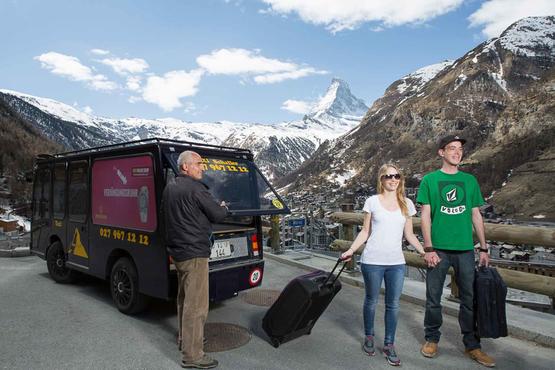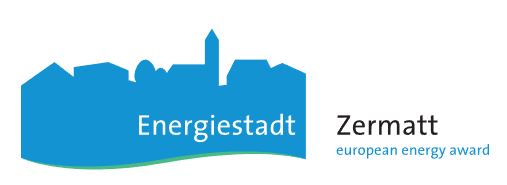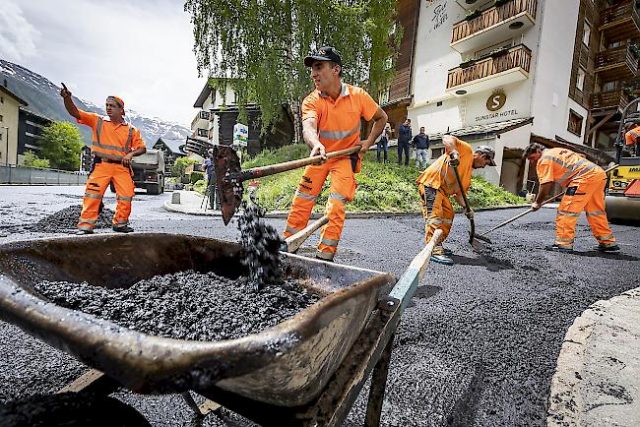Zermatt has a long history of commitment to sustainability, and has recently been recognised by the ‘Swisstainable’ project.
In this blog post we look at the many ways that Zermatt is working on sustainability within this famous Swiss resort.
- Train Travel to Zermatt
- Zermatt is Car Free
- Electric Buses and Taxis
- An ‘Energy City’
- Renewable Electricity
- Solar Power
- Efficient piste bashers
- Recycled plastic roads
- Climate Detectives
- Recycling
- Pure mountain water
What is Swisstainable?
‘Swisstainable’ is a new project launched by Switzerland Tourism Board earlier this year. The aim is to create a new approach to tourism that fits the country’s well-established eco credentials.
The Swiss Federal Council has committed to a climate-neutral Switzerland by 2050, making it the world’s most sustainable destination. Swisstainable is still in the early stages, with the goal of major changes by 2023.
Zermatt has now met their Level 1 criteria, according to the official thresholds.
Train Travel to Zermatt
Whether you travel to Zermatt from Geneva, from Zurich or all the way from the UK, the obvious most sustainable way to get to Zermatt is to travel by train.
This low carbon method of travel is easy in Switzerland. Every day, around 9000 trains travel across the 3000 kilometres of track on the SBB network.
The impact of train travel is further reduced as Swiss Federal Railways generates 90% of the electricity needed from renewable hydropower.
Zermatt is Car Free
Whichever method of transport you use for the main part of your journey to Zermatt, the final leg will always be by train as Zermatt is a car-free resort.
If your entire journey to Zermatt is not already by train, you will need to park your car in Tasch, before catching the 12-minute final connection to resort.
Click here for information about electric car charging in Zermatt
Electric Buses and Taxis
There are no cars in the resort of Zermatt, so holidaymakers are served by electric taxis and electric buses that whisk you around resort.
You can find out about the history of electric taxis in Zermatt in our blog post on the topic.
If you are an owner of your own electric vehicle, there are several EV chargers in Tasch that you can use.

Zermatt is an ‘Energy City’
Zermatt has been an ‘Energiestadt’ (‘energy city’) since 2016, committing the resort to a sustainable energy policy.
The aim is to maximise energy-saving measures to increase efficiency, reduce the consumption of fossil fuels and use locally produced renewable energy instead.
Local residents and business owners have been given energy saving tips and advice, and new buildings are subject to new regulations governing heating, hot water, solar energy and insulation.

Renewable Electricity
The Zmutt dam above Zermatt collects water from the glacier above and the Zmuttbach river.
This water is pumped back up the mountain at low demand periods to 2400m, then released to generate renewable hydro power as it flows back at high speed to the Lac de Dix dam.

Solar Power
Look carefully and you will see many solar panels around Zermatt.
The impressive Matterhorn Glacier Paradise 3S lift base station was fitted with 485 photovoltaic panels, covering a surface area of 877m2 and capable of generating 157,000 kWh of energy a year. That’s enough to supply 35 households and save 23.4 tonnes of CO2 per annuum.
The top station restaurant at Klein Matterhorn generates enough energy from the PV system (108 panels generating 35’000 kWh pa) integrated in the building’s façade to cover all its heating, ventilation and lighting requirements for the entire year.
It’s helped by the clear air in the mountains, making it up to 80% more productive than in the rest of the country. The innovative design led to the award of a European Solar Prize.
There are also 99 solar panels generating 20’000 kWh annually at TrocknerSteg and the Kinhütte refuge was also fitted with eco-friendly, sustainable solar panels in 2020.

More efficient piste bashers
Zermatt operates 68 diesel-fuelled vehicles, including 29 snow groomers, which maintain and keep the slopes safe.
To mitigate the impact of the one million litres of diesel used per year, Zermatt uses ‘eco speed’ diesel, which generates 11% less carbon monoxide, 3% less nitric oxide emissions and 13% lower particle mass.

Roads made of recycled plastic
Regular visitors to our blog may remember that we previous reported that Zermatt innovated by reapplying the tarmac on a village road with a mix that includes recycled plastic.

Join the Climate Detectives
Zermatt is also trying to do more to help children understand climate change.
This summer adventure with resort children’s mascot Wolli is free and features an audio guide and map that you can follow to learn more about the challenges facing the Alps

First-class Recycling
Zermatt has a comprehensive recycling system that includes glass, cans, paper, cardboard and bio-organic waste.
In addition, mobile collection points are available for disposal of items such as computers, phones, batteries, Nespresso capsules and clothing.

Pure mountain water
Zermatt’s drinking water is 100% pure spring water, disinfected with a simple sodium hypochlorite solution as a precaution.
This high quality water is drawn from 141 springs and transported through 31km of pipes from the springs to the village.
This water is also used to make our wonderful Zermatt beer!

Serviced Chalets and Apartments in Zermatt
If you want to know more about your travel options or to talk to someone about booking accommodation in Zermatt, give one of our team a call or look at our website.
